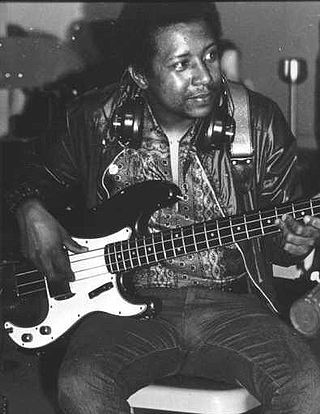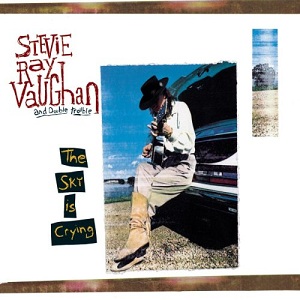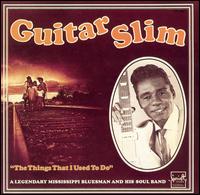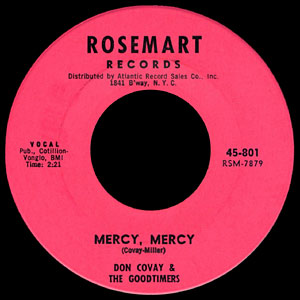
James Marshall "Jimi" Hendrix was an American guitarist, songwriter and singer. He is widely regarded as one of the greatest and most influential guitarists in the history of popular music. Inducted into the Rock and Roll Hall of Fame in 1992 as a part of his band, the Jimi Hendrix Experience, the institution describes him as "arguably the greatest instrumentalist in the history of rock music."

The Isley Brothers are an American soul group originally from Cincinnati, Ohio, that began as a vocal trio consisting of the brothers O'Kelly Isley Jr., Rudolph Isley and Ronald Isley in the 1950s. With a career spanning over seven decades, the group has enjoyed one of the "longest, most influential, and most diverse careers in the pantheon of popular music".

Stephen Ray Vaughan was an American musician, best known as the guitarist and frontman of the blues rock trio Stevie Ray Vaughan and Double Trouble. Although his mainstream career spanned only seven years, he is regarded as one of the most influential musicians in the history of blues music, and one of the greatest guitarists of all time. He was the younger brother of guitarist Jimmie Vaughan.

Are You Experienced is the debut studio album by the Jimi Hendrix Experience, released in May 1967. The album was an immediate critical and commercial success, and is widely regarded as one of the greatest albums of all time. It features Jimi Hendrix's innovative approach to songwriting and electric guitar playing, which soon established a new direction in psychedelic and rock music as a whole.

Axis: Bold as Love is the second studio album by the Jimi Hendrix Experience. It was first released by Track Records in the United Kingdom on December 1, 1967, only seven months after the release of the group's highly successful debut album, Are You Experienced. In the United States, Reprise Records delayed the release until the following month. The album reached the top ten in the album charts in both countries.
"Little Wing" is a song written by Jimi Hendrix and recorded by the Jimi Hendrix Experience in 1967. It is a slower tempo, rhythm and blues-inspired ballad featuring Hendrix's vocal and guitar with recording studio effects accompanied by bass, drums, and glockenspiel. Lyrically, it is one of several of his songs that reference an idealized feminine or guardian angel-like figure. At about two and a half minutes in length, it is one of his most concise and melodically focused pieces.

T-Neck Records was a record label founded by members of the R&B/soul group The Isley Brothers in 1964, which became notable for distributing the first nationally-released recordings of Jimi Hendrix, their guitarist, and which later became a successful label after the Isleys began releasing their own works after years of recording for other labels, scoring hits such as "It's Your Thing" (1969) and "That Lady" (1973).

Band of Gypsys is a live album by Jimi Hendrix and the first without his original group, the Jimi Hendrix Experience. It was recorded on January 1, 1970, at the Fillmore East in New York City with R&B musicians Billy Cox on bass and Buddy Miles on drums, a grouping frequently referred to as the Band of Gypsys. The album mixes funk and R&B elements with Hendrix's psychedelic rock guitar and wah pedal-based jamming, an approach which later became the basis of funk rock. It contains previously unreleased songs and was the last full-length Hendrix album released before his death six months later.
"Red House" is a song written by Jimi Hendrix and one of the first songs recorded in 1966 by the Jimi Hendrix Experience. It has the musical form of a conventional twelve-bar blues and features Hendrix's guitar playing. He developed the song prior to forming the Experience and was inspired by earlier blues songs.

"Voodoo Child (Slight Return)" is a song written by Jimi Hendrix and recorded by the Jimi Hendrix Experience in 1968 that appears as the final track on the groups's third studio album, Electric Ladyland, released that year. It contains improvised guitar and a vocal from Hendrix, backed by Noel Redding on bass and Mitch Mitchell on drums. The song is one of Hendrix's best known; it was a feature of his concert performances throughout his career, and several live renditions were recorded and released on later albums.

William Cox is an American bassist, best known for performing with Jimi Hendrix. Cox is the only surviving musician to have regularly played with Hendrix: first when both were in the Army, then in 1969 with the experimental group that backed Hendrix at Woodstock, followed by the trio with drummer Buddy Miles that recorded the live Band of Gypsys album, and, lastly, The Cry of Love Tour trio with Mitch Mitchell back on drums. Cox continues to perform dates with the Band of Gypsys Experience and the Experience Hendrix Tour.

The Sky Is Crying is the fifth and final studio album by Stevie Ray Vaughan and Double Trouble, compiling songs recorded throughout most of their career. Released 14 months after Vaughan's death in 1990, the album features ten previously unreleased tracks recorded between 1984 and 1989. Only one title, "Empty Arms", appeared on any of the group's previous albums. The tracks were compiled by Vaughan's brother, Jimmie Vaughan, and was Vaughan's highest charting album at number 10.

"The Things That I Used to Do" is a blues standard written by Guitar Slim. He recorded it at Cosimo Matassa's J&M Recording Studio in New Orleans, where the young Ray Charles arranged and produced the session. Specialty Records released the song as a single in 1953 and it became a bestseller the following year. Specialty founder Art Rupe believed that the appeal would be limited to the Southern U.S. rural audience. However, urban rhythm and blues radio stations in the North began airing the song and built it into a national hit. As a result, Guitar Slim became in great demand as a performer and played at venues such as the Apollo Theater in New York City.
"Third Stone from the Sun" is a mostly instrumental composition by American musician Jimi Hendrix. It incorporates several musical approaches, including jazz and psychedelic rock, with brief spoken passages. The title reflects Hendrix's interest in science fiction and is a reference to Earth in its position as the third planet away from the sun in the solar system.

"Mercy, Mercy" is a soul song first recorded by American singer/songwriter Don Covay in 1964. It established Covay's recording career and influenced later vocal and guitar styles. The songwriting is usually credited to Covay and Ron Alonzo Miller, although other co-writers' names have also appeared on various releases.
"Come On" is a song written by New Orleans rhythm and blues artist Earl King. He first recorded the song as "Darling Honey Angel Child" in 1960 for the Ace Records subsidiary Rex. Later that year, he recorded it as a two-part song for Imperial Records using some new lyrics. Retitled "Come On", it was released in 1960 with "Come On – Part I” as the A-side backed with “Come On – Part II”.

Rainbow Bridge is a posthumous album by the American musician Jimi Hendrix. It was released in October 1971 through Reprise Records, and was produced by Mitch Mitchell, Eddie Kramer, and John Jansen, with Hendrix receiving a production credit as well. The album was the second released after Hendrix's death to consist primarily of previously unreleased studio material, much of which was intended for a potential fourth studio album.
The Soul to Soul Tour was a concert tour through North America, Europe and Australasia, undertaken by American blues rock band Stevie Ray Vaughan and Double Trouble from 1985 through 1986. At the beginning of the tour, the band had finished recording their album Soul to Soul. Their commercial and critical acclaim had been demonstrated during the Couldn't Stand the Weather Tour in 1984, when they had played before a sold-out audience at Carnegie Hall. Longing for opportunities to expand the group's lineup, Vaughan and Double Trouble hired keyboardist Reese Wynans during the Soul to Soul recording sessions in Dallas, Texas. Throughout the tour, the band's success was confirmed as their performances consistently amazed and gratified their audiences.

Radio One is a live album by The Jimi Hendrix Experience. It was released posthumously in November 1988 by Rykodisc and compiles tracks recorded between February and December 1967 for broadcasts by BBC Radio. The album peaked at number 30 on the UK Albums Chart while it charted at number 119 on the Billboard 200 in the United States. After Hendrix's family gained control of his legacy, Radio One was supplanted by the more comprehensive BBC Sessions in 1998.














